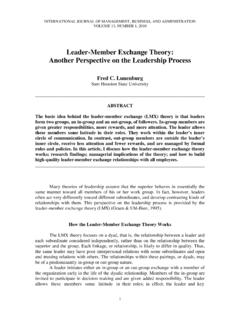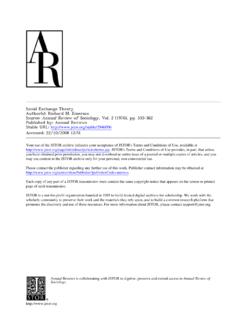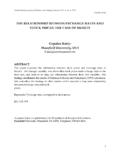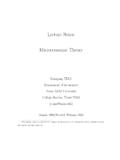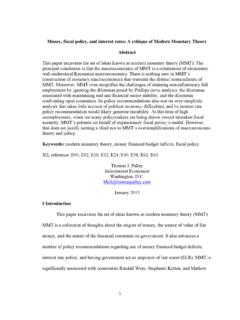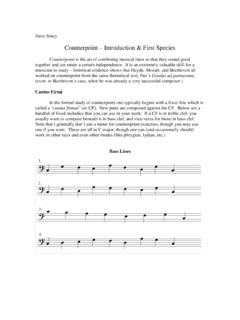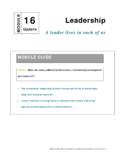Transcription of The Theory of Exchange Rate Determination
1 This PDF is a selection from an out-of-print volume from the National Bureauof Economic ResearchVolume Title: Exchange Rate Theory and PracticeVolume Author/Editor: John F. O. Bilson and Richard C. Marston, Publisher: University of Chicago PressVolume ISBN: 0-226-05096-3 Volume URL: Date: 1984 Chapter Title: The Theory of Exchange Rate DeterminationChapter Author: Michael L. MussaChapter URL: pages in book: (p. 13 - 78)1 The Theory of Exchange Rate Determination Michael Mussa Introduction This essay develops an integrated model of Exchange rate behavior that synthesizes many recent and older contributions to the Theory of Exchange rate Determination .
2 Since the task of Exchange rate Theory is to explain be- havior observed in the real world, the essay begins (in sec. ) with a summary of empirical regularities that have been characteristic of the behav- ior of Exchange rates and other related variables during periods of floating Exchange rates . This discussion continues (in sec. ) with the presentation of a schematic model of the Exchange rate as an asset price that depends on a discounted sum of economic factors that are expected to affect the foreign Exchange market in present and future periods.
3 This schematic asset price model implies a convenient decomposition of Exchange rate changes into their expected and unexpected components; and it suggests a general explanation for the dominance of the random, unexpected component of Exchange rate change in actual Exchange rate movements. Specific content for the schematic asset price model of the Exchange rate is provided (in sec. ) by considering a reduced-form expression for the condition of money market equilibrium in which both the level and the expected rate of change of the Exchange rate affect the demand to hold domestic money.
4 Under the assumption of rational expectations, this re- duced-form equilibrium condition implies that (the logarithm of) the nominal Exchange rate is an exponentially weighted average of expected future dif- ferences between (the logarithms of) the nominal money supply and the exogenous component of money demand. This result, which allows a key role for expectations concerning future money supply and money demand behavior in determining the current Exchange rate, is contrasted with simple monetary models that focus on current money supplies and current money demands as the determinants of Exchange rates .
5 13 14 Michael Mussa An alternative asset price model of the Exchange rate emerges (in sec. ) from a reduced-form expression of the condition of balance of pay- ments equilibrium that is derived from an extended version of the standard two-country model of international trade. This model, which focuses on the real Exchange rate and other real variables, embodies the essential ideas of the elasticities and absorption approaches to the balance of payments and the traditional partial equilibrium model of the foreign Exchange market. Under the assumption of rational expectations, the model yields an expres- sion for the current real Exchange rate as a discounted sum of the expected future values of the exogenous real factors that affect excess demands for foreign and domestic goods and the desired relationship between spending and income.
6 From this result conclusions may be derived concerning the relationships among the real Exchange rate, the current account balance, and the net stock of foreign assets. Combination of the reduced-form models of monetary and balance of pay- ments equilibrium yields (in sec. ) an equilibrium model of the determi- nation of the Exchange rate. This model illustrates the coordinate importance of monetary factors affecting the supply and demand for money and real factors affecting excess demands for specific goods and of the desired rela- tionship between spending and income in influencing the behavior of the Exchange rate.
7 Modification of this equilibrium model by the introduction of an appropriately specified adjustment rule for the domestic money price of domestic goods (in sec. ) results in a disequilibrium model of the ex- change rate in which monetary disturbances have real effects on levels of output, relative prices, and the real Exchange rate. The model illustrates the phenomenon of Exchange rate overshooting in response to monetary dis- turbances and the role of such disturbances in inducing temporary diver- gences from purchasing power parity. The essay concludes with a brief sum- mary and a discussion of possible extensions.
8 Empirical Regularities and Their Theoretical Implications A central objective of theoretical models of Exchange rate Determination ought to be a clearer understanding of the economic mechanisms governing the actual behavior of Exchange rates in the real world and of the relation- ships between Exchange rates and other important economic variables. In surveying theoretical models of Exchange rate Determination , therefore, it is appropriate to examine the empirical regularities that have been characteris- tic of the behavior of Exchange rates and other related variables under float- ing Exchange rate regimes.
9 It is also relevant to discuss the minimum re- quirements for any theoretical model of Exchange rate Determination to be consistent with these empirical regularities. 1. Empirical regularities in the behavior of Exchange rates and their implications for ex- change rate Theory are discussed in Mussa (1979); see also Dooley and Isard (1978), Frenkel and Mussa (1980), lsard (1980), and Frenkel (1981). 15 The Theory of Exchange Rate Determination I The Stochastic Behavior of Exchange rates and Related Variables Experience with floating Exchange rates between the United States dollar and other major currencies (the British pound, the German mark, the French franc, the Swiss franc, and the Japanese yen) during the 1970s has revealed five general characteristics of the behavior of Exchange rates and related variables under a flexible Exchange rate regime in which the authorities do not intervene too actively in the foreign Exchange markets.
10 These character- istics also apply, in general, to the experience with floating Exchange rates between major currencies during 1920s and 1930s and, with some modifi- cations, to the experience of floating Exchange rates between the United States and Canadian dollars during the 1970s. They do not always apply, however, to situations in which Exchange rates have been very actively man- aged, such as the Exchange rate between the Mexican peso and the United States dollar or the Exchange rates between currencies within the European Monetary System. First, statistical examination of the behavior of (logarithms of) spot ex- change rates reveals that they follow approximately random walks with little or no drift.










